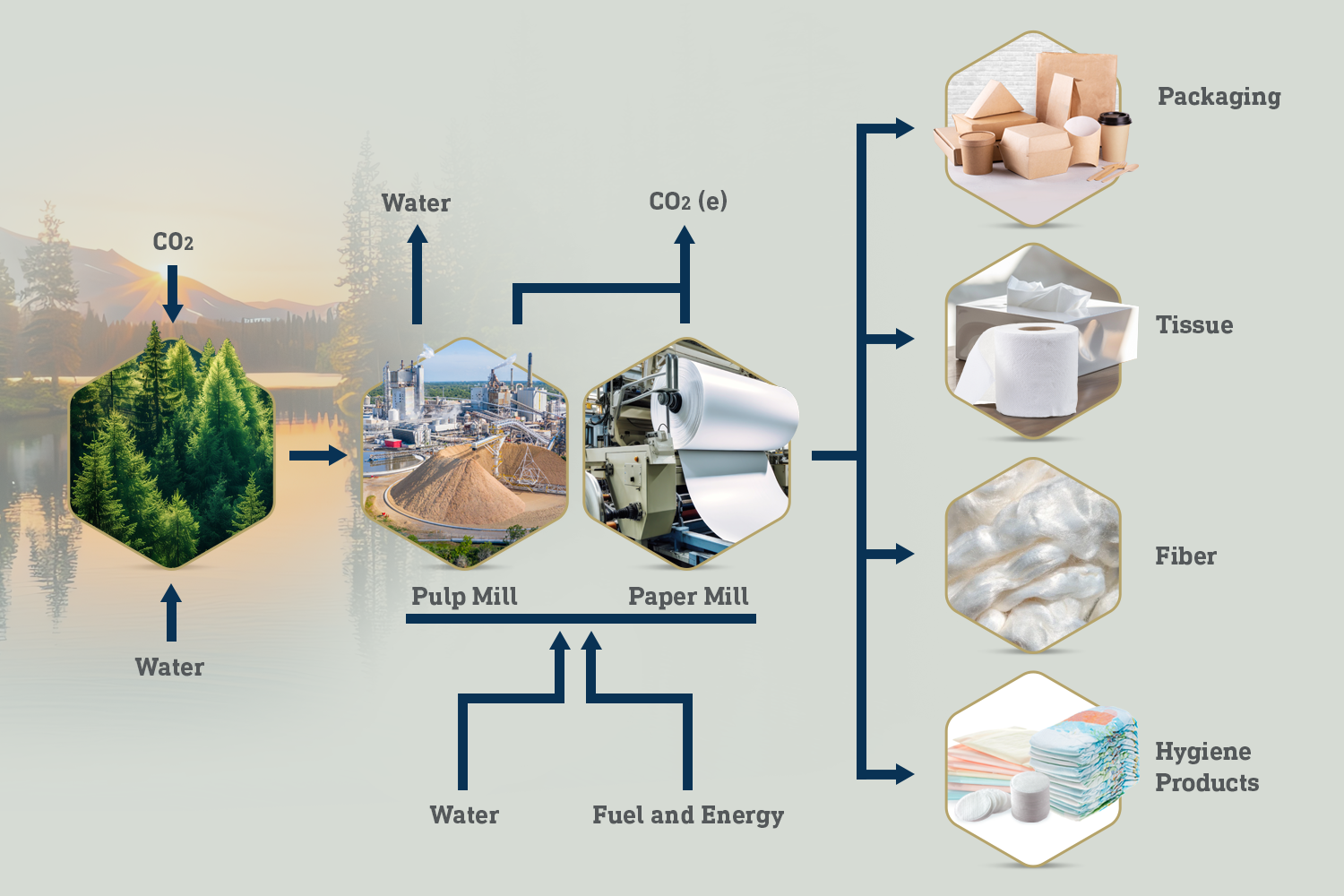Pulp, Paper, Packaging and Tissue
From tree to tissue — or to package, stationery, magazine, newspaper, or thousands of other products — pulping liberates fibers from woody plants and then rearranges them into new end products.
Currently, our industry’s highest priority is decarbonizing manufacturing processes. An integrated pulp and paper mill’s energy needs heavily depend on biomass combustion. However, we have abundant opportunities to reduce dependency on fossil fuels and make these processes more energy efficient.
Several areas of research needs being investigated include:
• Recovery loop efficiency improvement.
• Lime kiln alternatives, such as bio-based energy sources or low-carbon fuels and electrification.
• Reducing evaporative energy in drying the paper web.
• Carbon Capture of biogenic and fossil emissions with some form of beneficial use.
There is also a focus on non-integrated mills, which lack biomass boilers. Consequently, evaporative energy is solely fossil based with high electricity and water demands.
Resource conservation is also a focus of our research efforts.

Pulping
In the 1950s, the kraft chemical pulping process became the dominant technology for isolating wood fiber from wood chips. While this produces strong pulp and efficiently delivers raw materials and energy, the yield is not ideal and has an inherent capital intensity for the investor.
Advanced processes under investigation include modeling tools for evaporation of water from spent pulping liquor and techniques to eliminate equipment fouling. Advanced membrane technologies are expanding capabilities for cost-effective separation of organics and inorganics from spent pulping liquor. This opens new possibilities for reducing energy intensity and even more efficient reuse of process streams.
Understanding the pathways of erosion and corrosion, and developing means to eliminate them, can save millions in maintenance and replacement costs, as well as lost production. Analysis and testing capabilities include thermodynamic prediction and modeling of corrosion processes and recommendations for improved metallurgy to address the aggressive environments in these applications.
Paper
At RBI, we continue to explore the unlimited possibilities of paper. As the successor to the Institute of Paper Chemistry founded in 1929 by leaders of the pulp and paper industry, our mission is to create a body of knowledge and advance the industry.
Our researchers are working to understand and manage new ways in which:
• Fiber molecular structures can be coaxed to bond (or not)
• A sheet’s structure sheet can be formed
• Moisture, gases, oil, and grease can be absorbed or repelled
• Inks can be accepted or released
• Manufacturing and energy efficiency can be improved by formation and de-watering
These mechanisms — and more — are creating inspiration for new, twenty-first century products.
By taking the industry into this new era of technology and application of science, we continue to develop paper-based substrates and biocomposites for applications in electronics used in smart packaging; high-strength, light-weight panels for aviation and automotive uses; advanced technologies for paper, packaging and films; strength and fracture characteristics of paper for packaging; superamphiphobic paper for water and grease repellency; and auxetic papers that expand when stretched.
Innovative technologies have resulted in new applications, products, and materials from renewable, sustainable forest biomass.
New Product Innovations
RBI continues to address challenges and opportunities in fiber engineering and paper physics to yield a step-change in paper/packaging product performance. For those members who use the fundamental knowledge embedded in our staff and faculty’s fundamental knowledge, RBI creates a competitive edge and insight into the future of forest products.
In consumer products, technologies such as light dry crepe and through-air drying, and non-woven technologies such as spun bond, melt blown and spun lace are included in our faculty's expertise. The application of biomaterials will be expanded in consumer products within the next few years across the spectrum of disposables and single-use plastics to create a more sustainable offering within this segment of the industry.
Some new product innovations in paper board include smart packaging, coating solutions, printed electronics, renewable binders and adhesives and other chemicals of high value to customers, consumers, and society. The future advances and technologies in these areas are sure to touch every aspect of daily life around the globe.
Areas of Expertise:
Advanced Packaging Technology
New Coatings & Barriers
Decarbonizing Manufacturing Processes
Dissolving Pulp & Regenerated Cellulose
Paper & Board Mechanics
Printing Technology
Pulp and Paper Manufacturing
Tissue
Key Contacts:
For more information on RBI’s initiatives on Pulp, Paper, Packaging, and Tissue, and how to get involved, please contact one of our key contacts working in the area.

Chris Luettgen
Professor of the Practice, School of Chemical and Biomolecular Engineering, Director, Undergraduate Pulp & Paper Certificate Program
Email: chris.luettgen@rbi.gatech.edu
RBI Initiative Lead: Process Efficiency & Intensification of Pulp Paper Packaging & Tissue Manufacturing

J. Carson Meredith
Professor, School of Chemical and Biomolecular Engineering, Executive Director of the Renewable Bioproducts Institute

Rallming Yang
Research Scientist II, Renewable Bioproducts Institute
Email: rallming.yang@rbi.gatech.edu



